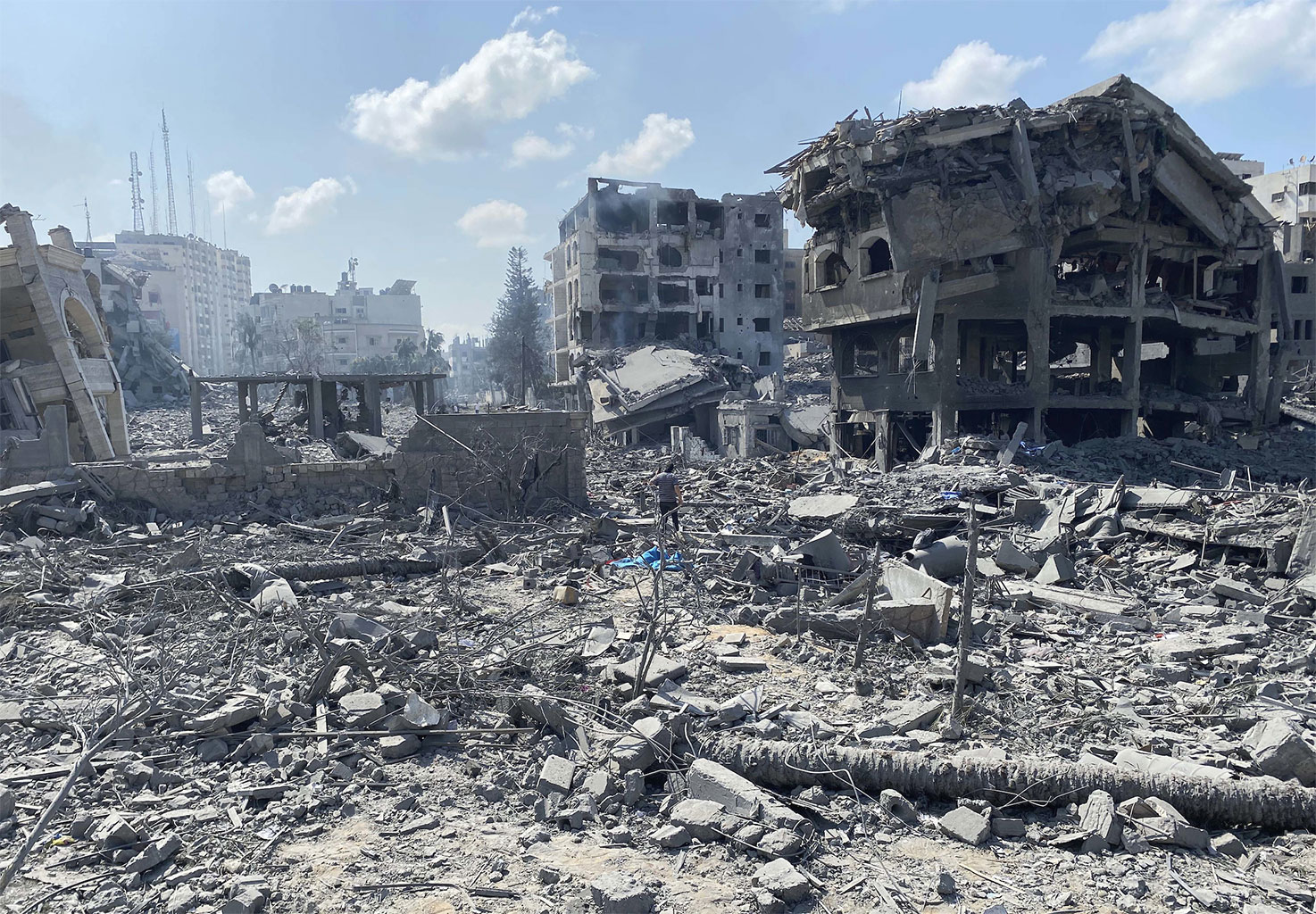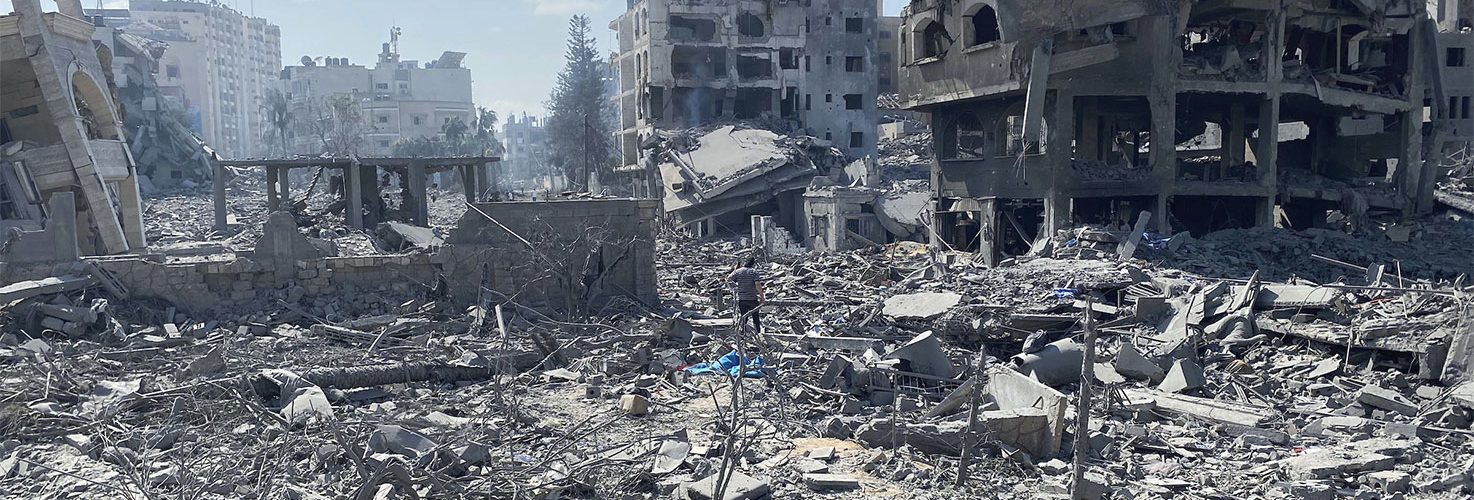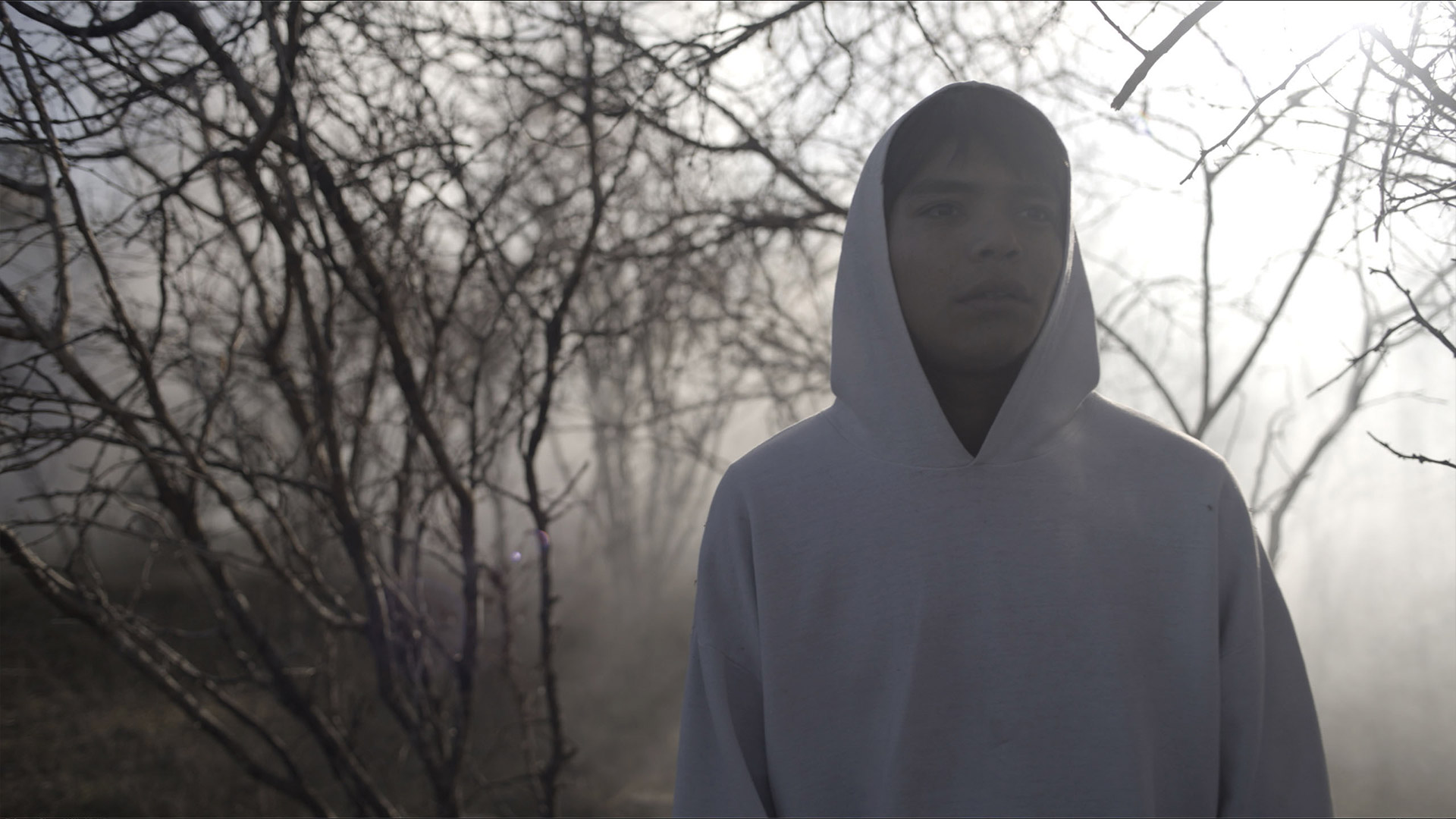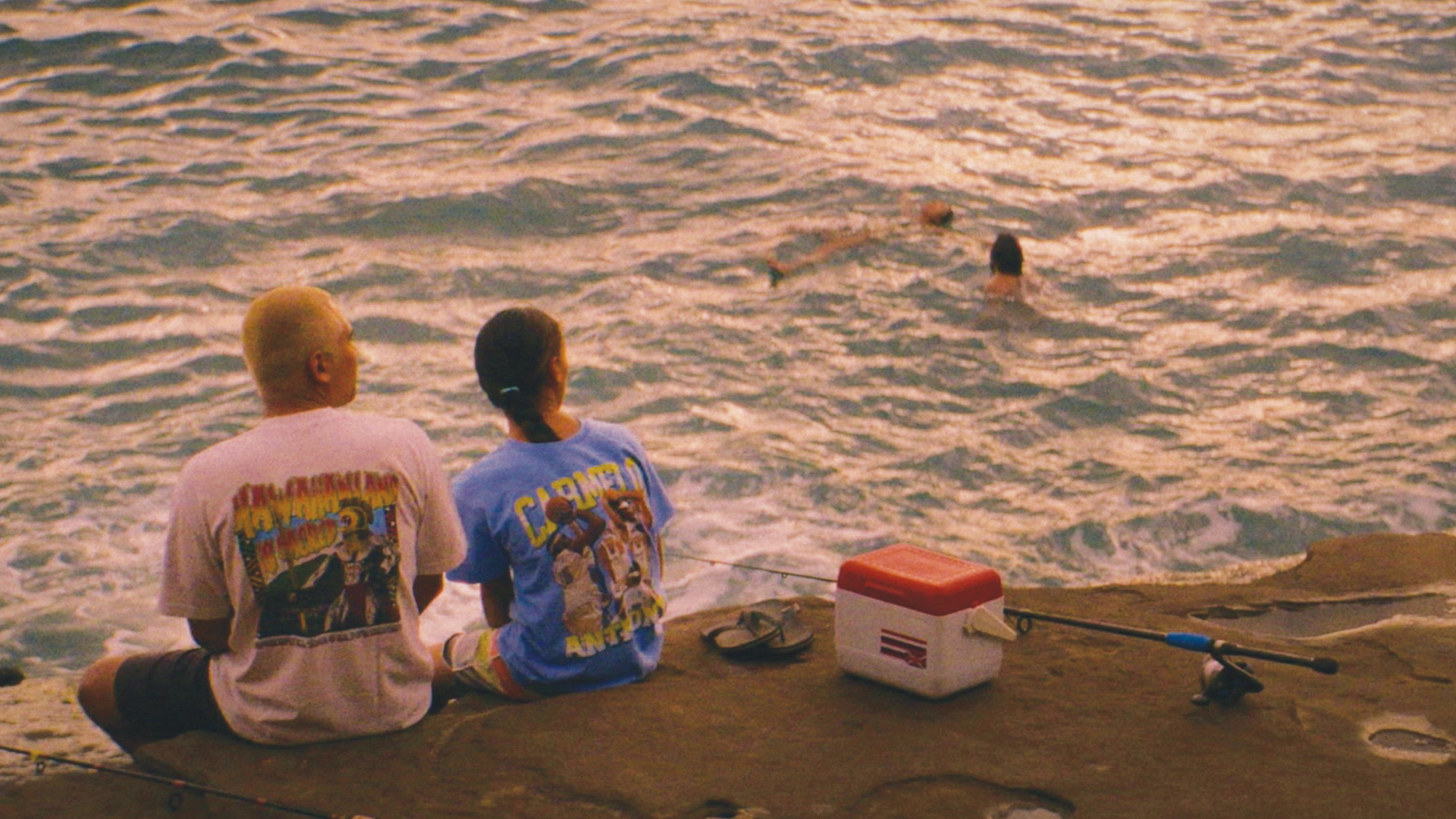
Palestinians inspect the damage following an Israeli airstrike on the El-Remal area in Gaza City on October 9, 2023. Licensed under the Creative Commons Attribution-Share Alike 3.0 Unported license. (Attribution: Palestinian News & Information Agency (Wafa) in contract with APAimages)
Early Media Limitations During the Current War on Gaza
Following Hamas’ attacks on Oct. 7, Israel imposed a total siege, which forbade food, water, electricity, and fuel from entering the Gaza Strip until two weeks later, when a trickle of aid trucks was permitted. Outside journalists were also barred from entering, leading to a reality where journalists who were not already inside Gaza were only able to cover the war from outside of Gaza. Due to their lack of firsthand access, mainstream Western media outlets tended to stray away from live coverage on the ground — though many flocked to Israel or the Israeli-occupied Palestinian territory in the West Bank in an attempt to get closer to the conflict.
The largest of the Arab media outlets that already had reporters on the ground in Gaza has remained Al Jazeera — which is funded in part by the Qatari government and lesser-known by average American audiences. Firsthand coverage has also gained increasing popularity through the reporting of Palestinian citizen journalists and influencers who live in Gaza, echoing similar circumstances in the United States during the 2020 Black Lives Matter uprisings for racial justice.
“Social media has allowed us access into people’s homes, and we have made a situation that was seemingly presented as this complex situation to be as this very straightforward situation,” Palestinian journalist and writer Mohammed el-Kurd shared on CBS News. “You have a people subjugating another people, and [with] this, we have been able to trespass the gatekeepers of mainstream media that don’t allow us to share our narrative.”
On Oct. 27 — three weeks after the Hamas attacks and amid an increase in Israeli bombardments on Gaza — news spread far and wide about the first total communications blackout imposed by Israel. For a 34-to-36-hour period, cell service and internet were almost completely unavailable in the Gaza Strip; another blackout took place beginning Oct. 31. Both aligned with a significant increase in Israel’s ground offensives and heavier bombardments. As the Committee to Protect Journalists warned, “A communications blackout is a news blackout. This can lead to serious consequences with an independent, factual information vacuum that can be filled with deadly propaganda, dis- and misinformation.”
Accessing social media through satellite uplinks and out-of-country SIM cards, Palestinian citizen journalists, such as Motaz Azaiza, Bisan Ouda, and Plestia Alaqad, were among the first to share somber messages regarding the communications blackout. Intermittently, they continued to update their social media accounts whenever they were able to access the internet — thus providing some of the most significant firsthand, on-the-ground images available in a time when most Western journalists were unable to enter the Gaza Strip. Yet it remains rare that their footage is incorporated into mainstream Western media, and many have allegedly faced attempts by social media platforms to ban or “shadow-ban” their account.
Long-Standing Allegations of Western Mainstream Media Bias
Analyzing the news headlines of mainstream media outlets can offer a clue into long-standing media biases that have been perpetuated throughout this current war. In December 2019, 416 Labs published its report “50 Years of Occupation,” which analyzed over 100,000 news headlines across 50 years from the Chicago Tribune, the Los Angeles Times, The New York Times, The Washington Post, and The Wall Street Journal about coverage on Palestine and Israel.
“The findings demonstrate a persistent bias in coverage of the Israeli-Palestinian issue — one where Israeli narratives are privileged and where, despite the continued entrenchment of the occupation, the very topics germane to Palestinians’ day-to-day reality have disappeared,” Owais Zaheer, one of the study’s authors, told The Intercept. “It calls to attention the need to more critically evaluate the scope of coverage of the Israeli occupation and recognize that readers are getting, at best, a heavily filtered rendering of the issue.”
As outlined by The Intercept, “The patterns identified seem to show a clear slant toward the Israeli perspective. … Since 1967, the year that the Israeli military took control of the West Bank, there has been an 85 percent overall decrease in mention of the term ‘occupation’ in headlines about Israel, despite the fact that the Israeli military’s occupation of Palestinian territory has in fact intensified over this time. … While subtle, a consistent disproportion in article headlines — which by default gives a greater airtime to one side or occludes certain key issues — can impact public perception.”
Arguing that Western media takes a “specific position of complicity,” Palestinian American writer and journalist Mariam Barghouti told The New Humanitarian, “It’s as if Palestinians don’t exist, except as dead bodies and images, or as terrorists screaming in the language that is not understood by much of the audiences that are observing this, especially in the English-speaking world and English-speaking media production.”
Barghouti noted that in certain interviews, journalists avoided showing both sides of the perspective — often interviewing only members of the Israel Defense Forces (IDF), for instance, and ignoring Palestinian voices. She continued, “What it is helping is in perpetuating a continued assault and a continued slaughter, when they should be able to inform audiences of what’s happening so that readers and viewers can make their own choice. This is being out of touch with reality. This is not bringing in the fact-checkers, and the people to really showcase and inform.”
Similarly, major news networks, such as MSNBC, CBS, and CNN, allegedly omitted coverage by or rescinded invitations to Palestinian and Arab guests. According to The Nation, “MSNBC claimed that the three Muslim-American hosts were removed only for logistical reasons and that their religion had nothing to do with the decision. One complexity of the story is that the three employees continued to appear on MSNBC as reporters and analysts even as they were sidelined as hosts.”
As Middle East analyst Omar Baddar shared on X, “I was recently booked & repeatedly confirmed on a major network. Day of, I was asked to summarize what I planned to say. When I obliged (US shouldn’t support war crimes, we need a cease fire, Palestinians need freedom, etc.), the producer said they could no longer squeeze me in.” Human rights attorney and professor Noura Erakat wrote on X, “They want us on to cry about our dead but not to provide context or discuss responsibility.”
In instances where Western media networks have interviewed Arab or Palestinian thinkers, network hosts have often sidelined important conversations around the history or the context from which Hamas was created, derailing the conversations instead with repeat inquiries about whether they condemn Hamas.
Selective Determination of Victimhood by Western Leaders
Since the war on Gaza began, President Joe Biden and many high-ranking officials in his administration have used word-for-word catchlines to describe their unequivocal support for Israel to defend itself. For weeks, such language was used alongside condemnations of Hamas, but with no mention of the Palestinian civilians who were killed in Gaza, even after the war began and thousands were killed. This changed on Oct. 13, after Israel called for half the population of Gaza — 1.1 million Palestinians — to move from the north to central or south Gaza for reasons of “safety.”
This move was criticized by humanitarian organizations as an “impossible” act of “forced displacement,” which is a war crime; furthermore, bombardments continued in central and southern Gaza during the period of migration was recommended — another war crime. After this newsworthy period, U.S. officials finally began to speak generally of the “humanitarian crisis” in Gaza and the need for aid. While continuing to repeat the same lines that “Israel has the right, indeed the obligation, to defend itself,” they began to note that the civilians should also be considered.
The State Department, however, continues to refuse to put limitations on Israel’s use of weaponry, trusting that Israel will ethically police its own actions. In a NATO Ministers of Defence meeting in Brussels, Belgium, U.S. Defence Secretary Lloyd Austin stated, “[Israel’s] is a professional military, led by professional leadership, and we would hope and expect that they would do the right things in the prosecution of their campaign” — despite Israel’s sustained and ongoing record of violating international law and committing war crimes.
“What we have seen from … Western leaders is an absolute support of Israel in its defense. … While they are right to condemn Hamas, while they are right to call for the release of hostages, they have been silent, and their silence is complicity, in relation to the crimes that are being committed against Palestinians,” noted Yasmine Ahmed, United Kingdom director of Human Rights Watch. Ahmed also noted that the 8,000 Palestinian civilians killed during the first two weeks were equivalent to “88% of the civilian population killed in Ukraine in 19 months,” yet “the world community quite rightly calls Russia to account, but has been silent in relation to this onslaught against Palestinians.”
During an April 2022 press conference regarding Russia’s war on Ukraine, National Security Council spokesperson John Kirby said, “It’s difficult to look at what [Putin is] doing in Ukraine, what his forces are doing in Ukraine, and think that any ethical, moral individual could justify that.” He then had to recompose himself as though he were about to cry.
A year and a half later, Kirby spoke of Israel’s attack on Gaza in a vastly different manner. He said, “This is war. It is combat. It is bloody. It is ugly, and it’s going to be messy. And innocent civilians are going to be hurt, going forward. … That doesn’t make it right. That doesn’t make it dismissable.”
On Oct. 31, Secretary of State Antony Blinken presented before the Senate Appropriations Committee, offering testimony for requesting an additional $106 billion in supplemental funding for defense interests abroad. Of that, $14 billion would be directed to Israel, adding to the approximately $3.8 billion the U.S. has given Israel every year since the Obama administration. During his speech — three weeks into the conflict — Blinken once again prioritized condemning Hamas’ activities and spoke nothing of the Palestinian people, period, despite the growing humanitarian crisis.
Meanwhile, the United States continued to brag about being the largest donor to Palestine, citing an increased $100 million in support at a time when aid trucks were unable to enter the Gaza Strip.
The Deliberate Targeting and Murder of Journalists
While downplaying the Palestinian plight through omission is one tactic, misinformation is another. In 2022, Palestinian American journalist and Al Jazeera reporter Shireen Abu Akleh was killed by the IDF. The IDF initially denied responsibility, but later investigations by neutral entities — such as the United Nations and several news organizations — concluded that “Israeli forces were almost certainly responsible.” According to The Guardian, the U.N. said Israeli soldiers fired “several single, seemingly well-aimed bullets” at Abu Akleh and other journalists.
Attacks on journalists are considered a war crime under international humanitarian law, yet between Oct. 7 and Nov. 27, the Committee to Protect Journalists has already tallied at least 50 journalists killed by Israel. Some incidents are more well-documented than others, including the Nov. 21 murder of two Lebanese journalists in south Lebanon and airstrikes that killed numerous family members of Al Jazeera Gaza Bureau Chief Wael Al-Dahdouh.
Yet investigations into such incidents can be time- and resource-intensive, thus temporarily quieting any allegations of misconduct. Early in the war, on Oct. 13, the “deliberate targeting” of a group of journalists near the Israel–Lebanon border killed Reuters videographer Issam Abdallah, seriously injured Agence France-Presse (AFP) correspondent Christina Assi, and blew up an Al Jazeera vehicle, injuring others. The ballistic analysis from RSF‘s preliminary investigation showed that the shots came from the direction of the Israeli border, and that two strikes happened within short succession to “clearly indicate precise targeting.” Furthermore, it was unlikely the journalists were mistaken for combatants given their vantage point atop the hill and highly visible “press” markings on their helmets, bulletproof waistcoats, and vehicles.
Momentum for Misinformation, Fed Through the Media Machine
Misinformation or obfuscation of reality can also be spread by Israeli leaders or media and then parroted by Western media or leaders at the highest levels, including people like President Joe Biden. Some of those claims are later rescinded, but often not until after they have been widely shared by mainstream media or gone viral on social media. Retractions are often not published or are underseen by audiences who do not engage beyond the initial wave.
At the start of the conflict, it was widely spread that Hamas had beheaded babies when it took hostages. Biden, in a press conference, claimed, “I never really thought that I would see and have confirmed pictures of terrorists beheading children.” The White House later walked back his comments after no evidence could be found.
One egregious piece of “evidence” posted by the IDF featured an Israeli soldier standing in front of a calendar inside Al-Shifa Hospital, claiming it was a “guardian list” with the Arabic names of Hamas “terrorists” who were in charge of their hostages. The video was quickly debunked as misinformation; the calendar showed the days of the week in Arabic. Nonetheless, the IDF has still not deleted the widely shared post, and a simple language check would have prevented mainstream networks from running the misinformation.
Other cases may be more complex, such as the confusion around the Oct. 17 bombing of the Al-Ahli Hospital. The destruction was initially paired with the Gaza Health Ministry’s claim that 500 were dead — though that number lowered to 471 the next day — and Western media cited even smaller numbers without stating how they reached their conclusions. Israel immediately denied responsibility, claiming it was a misfired rocket from Palestinian Islamic Jihad (PIJ), though PIJ has denied it. Results remain inconclusive even though the event was livestreamed by Al Jazeera and documented by a handful of other sources, which were later reviewed by The New York Times and The Wall Street Journal in independent investigations. Each came to a different conclusion about who was responsible for the strike, with The Times saying it may have come from the direction of Israel and The Journal saying it came from the direction of Gaza.
While the facts around Al-Ahli remain disputed, Israel has bombed hospitals, schools,
Yet while Israel justifies its attacks on hospitals with allegations that Hamas runs command centers in underground tunnels, it has yet to provide meaningful hard evidence, aside from uncorroborated videos of tunnels that are not seen in-depth and the presence of a set of guns and a Hamas-branded protective vest supposedly found in Al-Shifa. Furthermore, former Israeli Prime Minister Ehud Barak told CNN that Israeli contractors, in fact — not Hamas — built the underground bunkers in the 1980s.
Still, confusion around the Al-Ahli Hospital served to immediately cast doubt on information provided by the Gaza Health Ministry — which is managed by Hamas, the governing party of the Gaza Strip. Such doubt was perhaps most highlighted by Biden, who expressed no confidence in the death tolls. He said, “I have no notion that the Palestinians are telling the truth about how many people are being killed. I’m sure innocents have been killed and it’s the price of waging a war.”
In response, the Gaza Health Ministry came out in support of numbers provided by the Gaza Health Ministry.
“Everyone uses the figures from the Gaza Health Ministry because those are generally proven to be reliable,” said Omar Shakir, Israel and Palestine director at Human Rights Watch, in an interview with The Washington Post. “In the times in which we have done our own verification of numbers for particular strikes, I’m not aware of any time which there’s been some major discrepancy.”
Although U.S. leadership supposed that the Hamas-provided names may have been fabricated, the reality is that the White House State Department has used the Gaza Health Ministry’s numbers in a number of its reports. A senior Biden official has also suggested that death tolls supplied by the Gaza Health Ministry are likely an “undercount.” International news agencies also continue to use the numbers the Gaza Health Ministry supplies.
Paths Toward the Condemnation of Human Rights Abuses
Citing the ongoing “genocide” against Palestinians, Craig Mokhiber, director of the New York office of the U.N. high commissioner for human rights and a U.N. employee since 1992, stepped down from his position on Oct. 28. In a letter addressed to the U.N. high commissioner for human rights, he wrote of the U.N.’s inability to prevent previous genocides and called Israel’s current actions a “textbook case of genocide.”
“In Gaza, civilian homes, schools, churches, mosques, and medical institutions are wantonly attacked as thousands of civilians are massacred. In the West Bank, including occupied Jerusalem, homes are seized and reassigned based entirely on race, and violent settler pogroms are accompanied by Israeli military units,” he stated. “What’s more, the governments of the United States, the United Kingdom, and much of Europe are wholly complicit in the wholesale assault. Not only are these governments refusing to meet their treaty obligations ‘to ensure respect’ for the Geneva Conventions, but they are in fact actively arming the assault, providing economic and intelligence support, and giving political and diplomatic cover for Israel’s atrocities.”
Ultimately, the question is why, who, or what structures are to blame for the clear, persistent dehumanization of the Palestinian people. How is the war fought if the battlefield is the media? And what can be made of a tragic circumstance, now that the Palestinian plight for freedom from occupation is made more visible than ever?
“I think we are standing before a big opportunity,” Palestinian journalist Mohammed el-Kurd said during an October event at The People’s Forum in New York. “Netanyahu saying this about us being the ‘children of darkness,’ or their defense minister calling us ‘human animals‘ — saying the quiet part out loud — can be used to our benefit, but the response to it has to be unanimous.”
“We can make a big deal about this language, and we can mobilize against this language, but again, we have to be in unison,” he continued. “We need to be participating here, because the Palestinian resistance will never win on its own without internationalist support. When you look at this moment like an unprecedented moment that is full of grief and heartbreak — but it’s also full of incentives — it helps you step outside of your despair.”
Ω






